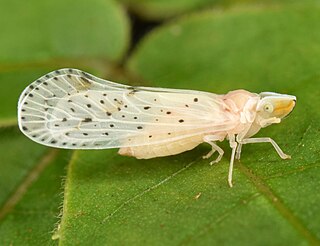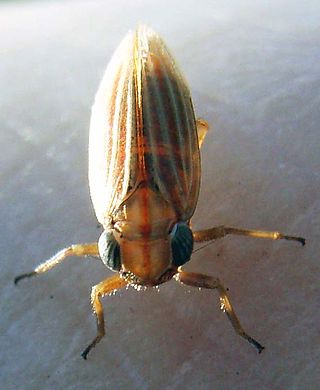
A planthopper is any insect in the infraorder Fulgoromorpha, in the suborder Auchenorrhyncha, a group exceeding 12,500 described species worldwide. The name comes from their remarkable resemblance to leaves and other plants of their environment and that they often "hop" for quick transportation in a similar way to that of grasshoppers. However, planthoppers generally walk very slowly. Distributed worldwide, all members of this group are plant-feeders, though few are considered pests. The infraorder contains 2 superfamily, Fulgoroidea and Delphacoidea. Fulgoroids are most reliably distinguished from the other Auchenorrhyncha by two features; the bifurcate (Y-shaped) anal vein in the forewing, and the thickened, three-segmented antennae, with a generally round or egg-shaped second segment (pedicel) that bears a fine filamentous arista.

Ricaniidae is a family of planthopper insects, containing over 400 species worldwide. The highest diversity is in tropical Africa and Asia and in Australia, with a few species occurring in the Palearctic and Neotropical realms. It is one of the smaller families in the planthopper superfamily Fulgoroidea.

The family Derbidae is a large and diverse group of planthoppers, widely distributed in the tropics and also found in subtropical and temperate regions. It includes more than 150 genera and more than 1500 species. The adults suck the sap of plants while the nymphs live mainly in decaying organic matter, for example under the bark of dead tree trunks, feeding on fungi. In some groups of species the general structure of the insects is largely uniform, whereas in others like in the subfamily Otiocerinae various forms can be found. For example, the shape of the head, the antennae or the wings can differ considerably among genera and species.

Acanalonia is a genus of planthopper and contains the majority of the species within the family Acanaloniidae. Species have been recorded from southern Europe and the Americas.

Issidae is a family of planthoppers described by Spinola in 1839, belonging to the order Hemiptera, suborder Auchenorrhyncha superfamily Fulgoroidea.

Nogodinidae is a family of planthoppers. They have membranous wings with delicate venation and can be confused with members of other Fulgoroid families such as the Issidae and Tropiduchidae. Some authors treat it as a subfamily of the Issidae.

Caliscelidae is a family of planthoppers, sap-sucking insects that belong to the order Hemiptera, suborder Auchenorrhyncha and superfamily Fulgoroidea. They are somewhat anomalous and have often been included within the family Issidae. Studies made in 2013 of the phylogeny of the Issidae and other groups using molecular techniques support the treatment of the group as a separate family. Sexual dimorphism can be marked. Some members of the family are called piglet bugs due to the shape of their snout. A particularly aberrant genus described in 2011 from India, Formiscurra, has males that resemble ants.

Formiscurra indicus is a species of planthopper in the family Caliscelidae found in southern India. A related species, Formiscurra atlas occurs in southwestern Ethiopia. Like others of its family they have short wings, suck plant sap and escape by leaping. The species shows great sexual dimorphism. The male of this half centimeter-long insect has an enlarged lobe in front of its head, the frons or metope, giving it an ant-like appearance. Females do not have such an enlarged structure but have a slightly long snout and differ slightly in body shape. The species is found mainly on low vegetation in open scrub and grass habitats.
Falcidius is a genus of planthoppers in the family Issidae.

Aplos is a genus of issid planthopper with only one species, Aplos simplex. It can be found in most of the Eastern United States and is now found as an invasive species in Northern Italy and Austria. Aplos simplex was formerly listed under the genus Thionia.

Elicinae is a subfamily of tropiduchid planthoppers in the family Tropiduchidae, with Elica the type genus.

The Achilixiidae are a family of Fulgoromorpha (planthoppers); species may be found in the neotropical and Asian regions. They are closely related to Achilidae and are sometimes included under Achilidae as a subfamily. Like Achilidae, species generally feed on several species of plant though the nymph stage has been found to feed on fungus. Like other planthoppers, the immature stage is covered in a wax which may help protect it from predators. Achilixiidae are small or medium sized for planthoppers and are greatly compressed, not depressed like the Achilidae.

Lycorma imperialis is a planthopper indigenous to parts of China and Indo-Malaysia. L. imperialis was originally discovered in 1846 by Adam White and has one recognized non-nominate subspecies, L. i. punicea. L. imperialis has undergone a number of reclassifications since its discovery and is one of four species in the genus Lycorma. L. imperialis follows a hemimetabolous life cycle and will undergo a series of nymphal stages (instars) before maturing to an adult.
Cheiloceps is a genus of planthoppers in the family Issidae. Cheiloceps was described as a genus by Uhler, 1895, downgraded by Fennah, 1955 to a subgenus of Thionia; then restored to genus status by Gnezdilov, 2018.

Fowlerium acutum is a species of planthopperin the family Issidae. They are native to central Texas and Oklahoma.
Waorania is the only genus of issid planthopper in the subtribe Waoraniina. The first two species in the genus were discovered in the forests of Ecuador.
Diceroptera is a genus of issid planthopper with one species, Diceroptera humboldti. It can be found in Venezuela.
Oronoqua is a genus of issid planthopper in the family Issidae and can be found in the northern Neotropics. The difference in fore and hind wing venations between species of Oronoqua and the other genera in Thioniini led to a subtribe Oronoquina being erected.

Rhotana is a large genus of planthoppers from the family Derbidae, tribe Rhotanini, with more than 70 species. Most species have been reported from the rainforests of Borneo, Indonesia and New Guinea, but the distribution of the genus extends over a much wider area in southern and south-eastern Asia, as far north as southern Japan and including parts of the Pacific islands as well as Australia. The species are the largest in the tribe Rhotanini, typically between 5–6 mm from head to the tip of the wings. The forewings frequently have striking patterns and colours, some species have also marks on the hind wings.

The Zoraidini is a group (tribe) of planthoppers in the family Derbidae. They are found in tropical and subtropical parts of Africa, Asia, Australia and in parts of the western Pacific. Almost 300 species in 27 genera are recognized. They are characterized by their long and narrow forewings and the short hind wings, usually not longer than half the length of the forewings and often even shorter. The forewings are typically around 8–10 mm long and the body is usually not more than half that length. In most species, the wings are raised when the insects are at rest, and are often spread out at an angle of about 45–90°. The head is compressed and the face is narrow in frontal view. The antennae are often long and the eyes cover about half the face. Like in other derbids, the adults suck the sap of plants while the nymphs live mainly in decaying organic matter. A few species are regarded as minor agricultural pests.















